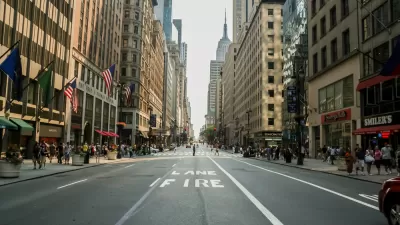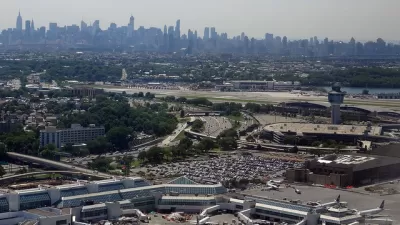The Big Apple may claim the nation's highest public transit ridership, but it ranks well below average in its use of freight rail. Two small short line railroads are at the center of a $100 million investment to reduce truck reliance.
When one thinks of trains in New York City, subways and commuter rail come to mind, not rumbling freight trains, though they do exist. Corey Kilgannon, a metro reporter who writes human interest stories for The New York Times, explores the increasing role in freight transport for the New York & Atlantic Railway, one of six short line railroads owned by Chicago-based Anacostia Rail Holdings.
New York & Atlantic operates on a handful of freight-only lines in Queens, Brooklyn and eastern Long Island mostly by sharing commuter lines run by the Long Island Rail Road, per a 1997 agreement.
The short-line railroad receives most of its loaded cars from trains operated by CSX Transportation, one of the nation’s largest freight railroad companies, and other railroads from north of the city. They snake down through the Bronx and over the Hell Gate Bridge into Queens, to New York & Atlantic’s cramped rail yard in Glendale, which has the Manhattan skyline for a backdrop.
"Despite the advantages, rail freight is still an under-utilized mode of transport here," wrote David Winzelberg in an earlier piece on the railway's expansion plans for Long Island Business News.
The New York area only gets about 2 to 3 percent of its freight by rail, where in many other areas in the country it’s well over 20 percent.
"To change that, city officials are investing tens of millions of dollars to upgrade the freight train’s corridors, including modernizing several rail depots," adds Kilgannon. The effort is part of $100 million plan by the New York City Economic Development Corporation (NYCEDC) to modernize New York’s freight distribution system.
Andrew Genn of NYCEDC describes the program, including a historical context, in an article last August in Global Railway Review.
A central policy goal of Freight NYC is to transform railroad infrastructure from having only the bare essentials to becoming a model of 21st century ingenuity. Starting in the 1960s, sparked by the expansion of the federal interstate highway system and the advent of containerisation, the city began disinvesting from its rail system.
Four-track electrified rights-of-way like the Bay Ridge Line in Brooklyn and Queens, which once carried thousands of railcars each day, shrank to a network with a single-track with few spurs carrying only dozens of railcars. Entire lines, including the Staten Island Railroad, simply closed when its major industrial customer moved operations out of the city.
The other short line that will see considerable investment from NYCEDC moves over water as well as land. Unlike its Queens-based counterpart, New York New Jersey Rail is publicly owned, established in 2005 and acquired by the Port Authority of New York and New Jersey in 2008.

Credit: Cross Harbor Freight Program, Port Authority of New York and New Jersey.
The short line marine railroad relies on barges and tugboats to transport freight rail cars from Greenville Yard in Jersey City, New Jersey, over New York Harbor to the 65th Street Yard in Sunset Park, Brooklyn, adjacent to the Brooklyn Army Terminal (see post).
The NYCEDC investment in Sunset Park is projected to result in 5,000 new jobs, reported Jaime DeJesus last July in the Brooklyn Reporter.
“Freight NYC is an investment in our city’s future,” said Mayor Bill de Blasio. “By modernizing our approach to shipping, we will create thousands of good-paying jobs while keeping our streets safer and cleaner.”
And that investment will boost business for NYNJR's sister shortline in Queens.
"For now, about 15 percent of New York & Atlantic’s rail cars are floated over from New Jersey, but that percentage will increase because of an expansion of the Cross Harbor Rail Freight Program, one of the country’s few remaining floating systems for rail freight," adds Kilgannon of the Times.
Additional reading from Untapped Cities on New Jersey-to-Brooklyn freight rail transport:
- New York Harbor May Get a New Freight Tunnel from NYC to New Jersey, Feb 2, 2018
- The Floating Freight Rail Line That Crosses the Hudson River in NYC, Feb. 2, 2017 [with video]
Hat tip to Sam Mintz, POLITICO Morning Transportation.
FULL STORY: The Pizza-and-Beer Train: New York City’s Hidden Railroad

Study: Maui’s Plan to Convert Vacation Rentals to Long-Term Housing Could Cause Nearly $1 Billion Economic Loss
The plan would reduce visitor accommodation by 25,% resulting in 1,900 jobs lost.

North Texas Transit Leaders Tout Benefits of TOD for Growing Region
At a summit focused on transit-oriented development, policymakers discussed how North Texas’ expanded light rail system can serve as a tool for economic growth.

Using Old Oil and Gas Wells for Green Energy Storage
Penn State researchers have found that repurposing abandoned oil and gas wells for geothermal-assisted compressed-air energy storage can boost efficiency, reduce environmental risks, and support clean energy and job transitions.

Private Donations Propel Early Restoration of Palisades Playground
Los Angeles has secured over $1.3 million in private funding to restore the Pacific Palisades playground months ahead of schedule, creating a modern, accessible space that supports community healing after recent wildfires.

From Blight to Benefit: Early Results From California’s Equitable Cleanup Program
The Equitable Community Revitalization Grant (ECRG) program is reshaping brownfield redevelopment by prioritizing projects in low-income and environmental justice communities, emphasizing equity, transparency, and community benefits.

Planting Relief: Tackling Las Vegas Heat One Tree at a Time
Nevada Plants, a Las Vegas-based nonprofit, is combating the city’s extreme urban heat by giving away trees to residents in underserved neighborhoods, promoting shade, sustainability, and community health.
Urban Design for Planners 1: Software Tools
This six-course series explores essential urban design concepts using open source software and equips planners with the tools they need to participate fully in the urban design process.
Planning for Universal Design
Learn the tools for implementing Universal Design in planning regulations.
Ascent Environmental
Borough of Carlisle
Institute for Housing and Urban Development Studies (IHS)
City of Grandview
Harvard GSD Executive Education
Toledo-Lucas County Plan Commissions
Salt Lake City
NYU Wagner Graduate School of Public Service




























